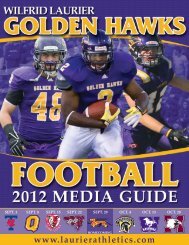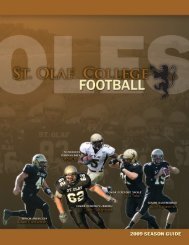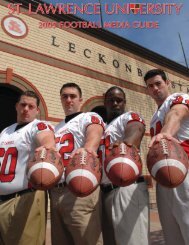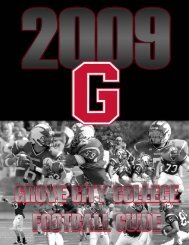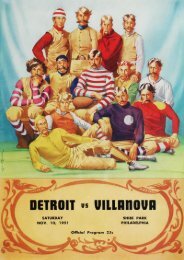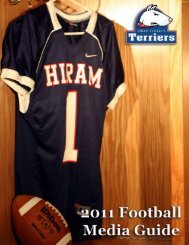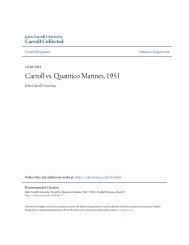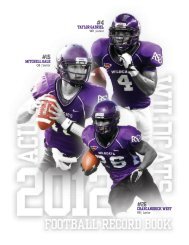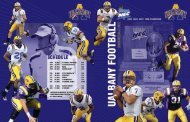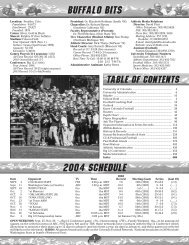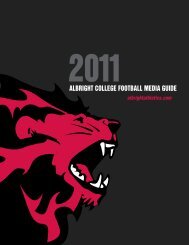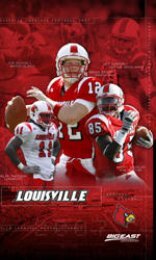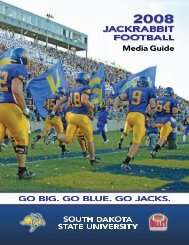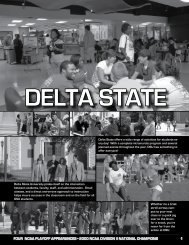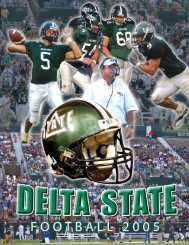UTAH/BRIGHAM YOUNG - of College Football Games
UTAH/BRIGHAM YOUNG - of College Football Games
UTAH/BRIGHAM YOUNG - of College Football Games
Create successful ePaper yourself
Turn your PDF publications into a flip-book with our unique Google optimized e-Paper software.
<strong>Football</strong> Thrills I Vividly Recall<br />
HRILLING football games we all remember? The<br />
Tmost thrilling, <strong>of</strong> course, are those in which<br />
your team wins decisively over a traditional foe<br />
after years <strong>of</strong> frustration, running up a thumping<br />
score. Only purists who like suspense want games<br />
settled in the few seconds. True blue sons <strong>of</strong> alma<br />
mater find suspense enough in wondering how high<br />
the final score will be, providing <strong>of</strong> course it is in<br />
their favor.<br />
But for those who consider football a game rather<br />
than an emotional purging <strong>of</strong> the soul, and believe<br />
it should contain elements <strong>of</strong> drama, let me look<br />
back on some purple afternoons.<br />
There was the meeting in 1946 <strong>of</strong> high-scoring<br />
giants Army and Notre Dame. A nation only recently<br />
released from war went mad. There were<br />
nearly 1,000,000 applications for tickets to the game<br />
in 74,000-capacity Yankee Stadium. No wonder.<br />
Army had Glenn Davis and Doc Blanchard. Notre<br />
Dame had Johnny Lujack, In addition, 11 others<br />
who played in that game won All-America recognition.<br />
And what happened? Army got inside Notre<br />
Dame's 33 six times but couldn't score. Notre Dame,<br />
in the one great <strong>of</strong>fensive spurt <strong>of</strong> the day, drove<br />
85 yards to the Army three, where Hank Foldberg<br />
tackled speedy Billy Gompers for no gain on fourth<br />
1600 Empire Rood - 486-1892<br />
by TED SMITS<br />
Associated Press General Sports Editor<br />
down. That was it. A scoreless tie, but memorable<br />
in a way no one expected.<br />
Then there was the 1956 Rose Bowl game between<br />
Michigan State and UCLA. Here partisan<br />
prejudice enters due to a casual acquaintance on<br />
my part with the campus <strong>of</strong> Michigan Agricultural<br />
<strong>College</strong> before it blossomed. My heart sank when<br />
an interception set up a touchdown for UCLA in<br />
the first three minutes, rose a bit when State tied<br />
the score, 7-7, soared when in the third period<br />
Clarence Peaks completed a 67-yard touchdown<br />
scoring play to John Lewis, and fell miserably when<br />
UCLA knotted it up at 14-14. No need to detail the<br />
churning play <strong>of</strong> the last period, full <strong>of</strong> red handkerchiefs<br />
<strong>of</strong> <strong>of</strong>ficials and much argument. With only<br />
seconds left, and the ball on the 24, Michigan State<br />
sent in Dave Kaiser, a substitute who had never<br />
made a field goal in college play. The ball was<br />
placed down on the 31 and Kaiser kicked. It was<br />
good, .17-14. In the Rose Bowl 100,809 people went<br />
somewhat crazy. I went crazier.<br />
Nor can I forget what happened at Austin, Texas,<br />
in 1961. Texas was the unbeaten, No. 1 team <strong>of</strong> the<br />
land, favored to beat Texas Christian by four touchdowns.<br />
Texas had the most exciting halfback <strong>of</strong><br />
the year in Jimmy Saxton. It also had one <strong>of</strong> the<br />
most promising young coaches, Darrell Royal. But<br />
TCU had courage and Sonny Gibbs, a 6-7 quarterback.<br />
In the second period Gibbs passed to Buddy<br />
lies for a 50-yard touchdown, and everyone sat<br />
back to watch Texas rise in its wrath. Texas rose,<br />
but not high enough. TCU achieved the year's biggest<br />
upset, 6-0. But what sticks in my mind is what<br />
happened afterward. The Texas publicity department,<br />
confident .<strong>of</strong> the outcome, had set up in<br />
advance a post-game press conference. A glum<br />
group gathered to wait for Darrell Royal. The minutes<br />
ticked by. Would he dare show up? He not only<br />
dared, but handled himself like the gentleman he is.<br />
But the greatest thrill I ever had in football came<br />
not in the press box but in a little gymnasium- on<br />
Staten Island in 1949. I was looking for an <strong>of</strong>fbeat<br />
story and decided to cover the Wagner-Susquehanna<br />
game. Susquehanna was coached jointly by Amos<br />
Alonzo Stagg, then a mere 87, and his son, Paul.<br />
Wagner also had a mighty coach, Jim Lee Howell,<br />
who went on to coach pro football's New York<br />
Giants. It was a high-scoring, wild and woolly<br />
game. At halftime I followed the Susquehanna<br />
team into the locker room, so informal were the<br />
arrangements. There I heard Stagg deliver, in a<br />
booming bass voice; the traditional fight talk. It<br />
made me understand why the playing field was<br />
ringed with long, black, chauffeured limousines<br />
out <strong>of</strong> which prosperous, affluent, gray-haired men<br />
descended, carefully hiding their cigars and cigarettes,<br />
to pay homage to "Mr. Stagg," their coach <strong>of</strong><br />
college days at Chicago. The fight talk, unfortunately,<br />
was not successful. Wagner won 41-27. But<br />
it was a great game and for me a great moment.<br />
47



